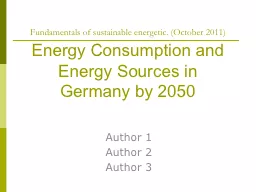

Energy C onsumption and Energy Sources in Germany by 2050 Author 1 Author 2 Author 3 Status quo Germany today Total area 357012m² Population 82 mill GDP 24trillion in 2010 ID: 247473
Download Presentation The PPT/PDF document "Fundamentals of sustainable energetic. (..." is the property of its rightful owner. Permission is granted to download and print the materials on this web site for personal, non-commercial use only, and to display it on your personal computer provided you do not modify the materials and that you retain all copyright notices contained in the materials. By downloading content from our website, you accept the terms of this agreement.
Slide1
Fundamentals of sustainable energetic. (October 2011) Energy Consumption and Energy Sources in Germany by 2050
Author 1
Author 2
Author 3Slide2
Status quo Germany todayTotal area: 357,012m²Population: 82 mill.GDP 2.4trillion in 2010Electricity imports: 42.1 TWhElectricity exports:
59.1
TWh
Energy resources
Coal
Oil
Natural gas
Nuclear
Energy
Renewable
EnergySlide3Slide4
Reduction of Energy ConsumptionUse of all available eco-friendly technologies
Lights.
Reducing of street lights, eliminate lights-advertisement for reduction of energy consumption and light-pollution.
Give feed-back on energy consumption, at least a monthly bill
Enable the consumer to level-out the energy consumption over the day to make use of smart grids
Combustion of fossil fuels for heating is inefficient as electrical heatingSlide5
Transport ITailormade transportation according to the needs and the traffic density (rush hour – rural areas)Cities: public transport, supported by measures like city-toll (
maut
)
Rural area:
Higher efficiency of infrastructure reduces the need of transportation, no need for long distances.
In rural areas, efficient cars can be justifiedSlide6
Transport II90% reducing of fossil fuel demand by new technologies and efficiency for cars (1-3liter cars, electro cars, etc.)Electro cars used also as electricity storageReduce energy need by decreasing of traffic
Offer transport resources at the point of need, i.e. car sharing, public transport, bicycles
Get away from the attitude one consumer-one car. That reduces the problems of stationary trafficSlide7
HousingHome heating. Zero energy homes (ZEH) – good insulation, solar or/and horisontal ground source heat pumps for water and room heating, solar or/and
wind electricity production
by house
, controllers for energy and water consumption at homes
Electricity.
Connect homes to electricity system – use energy from system if needed and donate energy to the system if it is overproduced by house
Water.
Rain water collection
for household needs
Create incentives for smart use of energy, i.e. flexible
tarifsSlide8
IndustryDemographic change leads to decrease of industry productionEnergy intensive industry sectors declineDecrease of production (there are too many things produced we don´t really need)
Introduce more measures, based on the footprint of a production. I.e. ease investment in greener technologies through tax-legislation
Food.
Use local food. Stop food waste and so reduce its production and transportation energy
needs
.
Save territory for wild life.
Paper
.
Eliminate paper advertisement
, packaging
.
Save forests and CO2/O2 balance.Slide9
People IParks. Plant more parks and forests to reduce CO2 amounts, to clean up the airWaste. Waste sorting and their reuse or recycling
Introduce a master plan to make the people think green in their decisions
give a feed-back in their taken decisions and make them benefit financially from it
Slide10
People IIIntroduce the ecological footprint in tax-legislationDo the right thing and benefit from itImpose certain taxes on efficient usage of energy. Higher taxes on fossil fuels and unjustified usageSlide11
Demography I~15 Million people less until 2050In Germany by 2050, the years with a strong birth rate are becoming erased due to their ageIntroduce measures to help supporting the scarcely populated regions and optimize it under energy-saving aspectsSlide12
Demography IIIndustries with high energy consumption are decreasing generally in Germany and are not labour intensive Change to the service industry, which is labour intensive solves the labour market problemEnvironmental- and labour market issues are disconnectedSlide13
How Much Energy Does Germany Need by 2050
Natural- and biogas for “high value energy” – industry
Heat pumps, geothermal and
solarthermic
sources for “low value energy” – housing, service sector
transportationSlide14
Source: Greenpeace: PlanB 2050 – Energiekonzept für DeutschlandSlide15
Source: Greenpeace: PlanB 2050 – Energiekonzept für DeutschlandSlide16
Possible Energy SourcesSolar PV. Even more potential than in the following graphSolar heating. Especially for housingGround source heat pumps for housing limited
by
regional
access
Wind.
Increase mainly in offshore wind parks
Hydropower.
Nearly constant amount of power plants
“Sustainable”
biomass.
No new areas of cultivation, but areas of compensationSlide17
Source: Greenpeace: PlanB 2050 – Energiekonzept für DeutschlandSlide18
ConclusionThere is no “right answer”, complex possibilitiesChanges are introduced by the people and require a change in attitudeA master-plan for the introduction of new technologies according to the expected lifetime
Close consideration of international collaboration (
im
- and export)
Smart grids and storage can contribute to the need of installed power plantsSlide19
Referenceshttp://www.youtube.com/watch?v=wIgVvPEVznc Alex Steffen: The shareable future of cities (TED)http://www.bmwi.de/BMWi/Navigation/Energie/Statistik-und-Prognosen/Energiedaten/gesamtausgabe.html Federal Ministry of Environment, Nature Conservation and Nuclear Safetyhttp://www.greenpeace.de/fileadmin/gpd/user_upload/themen/klima/Plan_B_2050_lang.pdf Studie: Klimaschutz
: Plan B 2050 – Energiekonzept für Deutschland
http://www.bmu.de/files/pdfs/allgemein/application/pdf/energieszenarien_2010.pdf
Studie: Energieszenarien für ein Energiekonzept der Bundesregierung